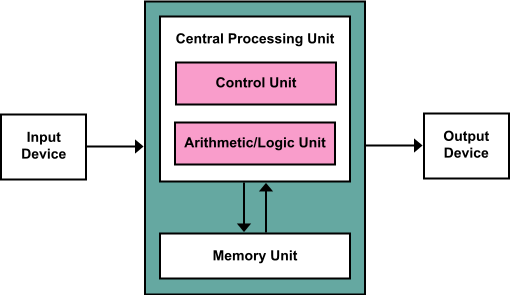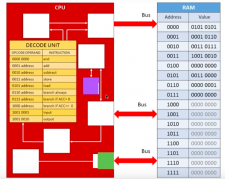Architecture of the central processing unit (CPU)
A central processing unit (CPU) is the electronic circuitry within a computer that carries out the instructions of a computer program by performing the basic arithmetic, logical, control and input/output (I/O) operations specified by the instructions. [1]
Major parts of a CPU[edit]
Below we see a simplified diagram describing the overall architecture of a CPU. You must be able to outline the architecture of the central processing unit (CPU) and the functions of the arithmetic logic unit (ALU) and the control unit (CU) and the registers within the CPU.
Please know and understand:
- Memory holds both data and instructions
- The arithmetic/logic gate unit is capable of performing arithmetic and logic operations on data
- A processor register is a quickly accessible location available to a digital processor's central processing unit (CPU). Registers usually consist of a small amount of fast storage, although some registers have specific hardware functions, and may be read-only or write-only[3]
- The control unit controls the flow of data within the CPU - (which is the Fetch-Execute cycle)
- Input arrives into a CPU via a bus
- Output exits the CPU via a bus
A more advanced discussion of a CPU[edit]
This is an excellent video discussing how a CPU actually works.
These videos are truly superb to help you understand parts of a CPU, and how they work.
Do you understand this topic?[edit]
Outline the architecture of the central processing unit (CPU) and the functions of the arithmetic logic unit (ALU) and the control unit (CU) and the registers within the CPU.
Parts of a CPU:
- ALU - The arithmetic logic unit executes all calculations within the CPU
- CU - control unit, coordinates how data moves around
Registers, a memory location within the actual processor that work at very fast speeds. It stores instructions which await to be decoded or executed.
- PC - program counter - stores address of the -> next <- instruction in RAM
- MAR - memory address register - stores the address of the current instruction being executed
- MDR - memory data register - stores the data that is to be sent to or fetched from memory
- CIR - current instruction register - stores actual instruction that is being decoded and executed
- ACC - accumulator - stores result of calculations
Buses
- address bus - carries the ADDRESS of the instruction or data
- data bus - carries data between processor and the memory
- control bus - sends control signals such as: memory read, memory write
Together, these buses may be referred to as the “system bus” or the “front-side bus”


